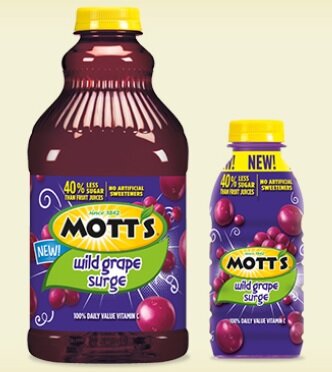100% Juice & Juice Drinks
Overview
Americans want variety and taste in the beverage products they consume. This is certainly apparent when it comes to the 100 percent juice and juice drink product category.
The producers, marketers, bottlers and distributors of 100 percent juice and juice drink beverages provide products that offer more than simple refreshment. Many of these products deliver vitamins, minerals and antioxidants.
One hundred percent juice is just that – 100 percent fruit juice with no added sugar. Juice drinks, however, contain less than 100 percent fruit juice, and often have other ingredients added such as water, flavors and sweeteners, including sucrose, fructose and glucose. In both cases, the exact amount is printed on the label above the nutrition facts panel. While the amount of vitamins or health benefits may vary depending on the beverage, 100 percent juice and juice drinks all can be enjoyed for their good taste and refreshment.
History
While staple juices like apple and orange have remained popular for decades, many new and exotic juice choices have entered the marketplace in recent years, such as pomegranate, mango, strawberry, grape, banana, cranberry, guava, kiwi and more. In addition to these varieties, beverage producers are now creating new and innovative juice combinations.
Individual-serving-sized bottled juices first became available during the 1970s and 1980s, proving to be a turning point for brands like, Tropicana® and Minute Maid®. Since then, both 100 percent juice and juice drinks have exploded exponentially. Other brands you may see on supermarket shelves today include Odwalla®, Dole®, Snapple®, Sunny Delight®, Naked® Juice and Veryfine®.
Many of today’s most popular 100 percent juices and juice drinks are made and marketed by the same companies that produce the world’s leading soft drinks, teas, sports drinks and bottled waters.




100% Juice & Juice Drink Types
100 percent pure or 100 percent juice
Juice that is directly squeezed from a fruit or vegetable. It can be made from juice concentrate that is reconstituted with water and contain certain other ingredients such as vitamins or minerals.
Juice Drink
A drink that contains less than 100 percent juice. A juice drink also may contain sweeteners and water. Juice drinks also may be known as juice cocktails, punch, drinks, sparklers, blends and beverages. Under U.S. law, juices and diluted juice beverages are required to list the total percent of juice content just above the nutrition facts panel.
Squeezed Juice
This term refers to the manner in which juice was extracted from fruit or vegetables. Squeezed juice is not pasteurized and must be kept under refrigeration.
Pasteurized Juice
Juice that has been heated (pasteurized) before packaging to increase shelf life, ensure safety and minimize nutrient loss.
Chilled, Ready-to-Serve
Juice made from frozen concentrate or pasteurized juice. It is packaged in paper cartons, plastic or glass containers.
From Concentrate
Juice that was manufactured as a frozen concentrate and later reconstituted.
Not from Concentrate
Juice that was packaged after it is squeezed. It has never been concentrated.
Frozen Concentrate
This juice has been concentrated and frozen. Prior to consumption, it must be reconstituted with water per the instructions on the container.
Frozen
Juice that is packaged and frozen without pasteurizing or further processing.
Canned Juice
Fruit or vegetable juice that has been heated and sealed in cans to provide for an extended shelf life. Once opened, canned juice should be refrigerated in a container other than the can it came in, and consumed within one week.
Juice in Aseptic Containers
This is a shelf-stable product that requires no refrigeration. It is pasteurized juice or juice from concentrate, packaged in sterilized containers or preserved by a specific sterilization technique.
Source: American Beverage Association


